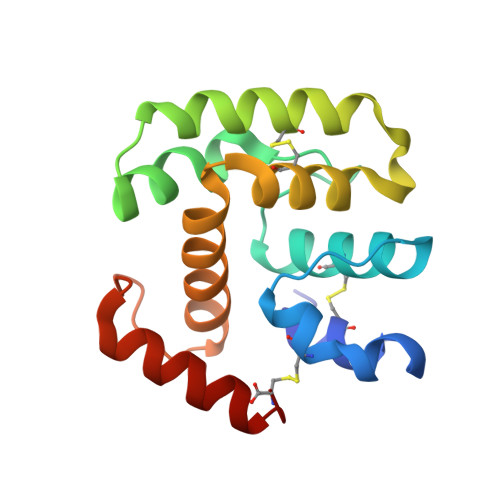The Crystal Structure of D7r4, a Salivary Biogenic Amine-binding Protein from the Malaria Mosquito Anopheles gambiae
Mans, B.J., Calvo, E., Ribeiro, J.M., Andersen, J.F.(2007) J Biol Chem 282: 36626-36633
- PubMed: 17928288
- DOI: https://doi.org/10.1074/jbc.M706410200
- Primary Citation of Related Structures:
2PQL, 2QEB, 2QEH, 2QEO, 2QEV - PubMed Abstract:
The D7-related (D7r) proteins of the malaria vector Anopheles gambiae have been shown to bind the biogenic amines serotonin, norepinephrine, and histamine with high affinity. One member of the group (D7r1 or hamadarin) has also been shown to have an anticoagulant/antikinin activity. To understand the mechanistic details of its antihemostatic/anti-inflammatory effects, we have determined the crystal structure of one member of this group, D7r4, along with the structures of ligand complexes with serotonin, tryptamine, histamine, and norepinephrine. The D7 fold consists of an arrangement of eight alpha-helices stabilized by three disulfide bonds. The structure is similar to those of the arthropod odorant-binding proteins, a relationship that had been predicted based on sequence comparisons. Although odorant-binding proteins commonly have six alpha-helices, D7r4 has eight, resulting in significantly different positioning and structure of the ligand binding pocket. The pocket itself is lined by hydrophobic side chains along with polar and charged groups oriented to form hydrogen bonds with the aliphatic amino group and with groups on the aromatic portions of the ligands. These structures, along with accompanying mutagenesis studies, have allowed us to identify critical residues for biogenic amine binding and to predict which members of the large D7 protein family found in blood-feeding nematocerous Diptera will function as biogenic amine-binding proteins.
Organizational Affiliation:
Laboratory of Malaria and Vector Research, NIAID, National Institutes of Health, Rockville, Maryland 20852, USA.
















